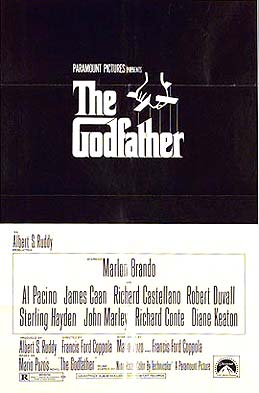The Godfather (1972)

One of the original "Movie Brats" who had not had a hit after seven films, director Coppola collaborated on the epic film's screenplay with Mario Puzo who had written a best-selling novel of the same name about a Mafia dynasty (the Corleones). The Godfather catapulted Francis Ford Coppola to directorial superstardom, and popularized the following euphemistic phrase (of brutal coercion): "I'm gonna make him an offer he can't refuse."
The almost three hour, R-rated saga film (for violence and graphic language) won three Oscars: Best Picture, Best Actor (Marlon Brando refused to accept the award) and Best Adapted Screenplay (Mario Puzo and Francis Ford Coppola). The other seven nominations included three for Best Supporting Actor (James Caan, Robert Duvall, and Al Pacino), Best Director, Best Sound, Best Film Editing, and Best Costume Design.
Gangster films are one of the oldest of film genres (starring Edward G. Robinson, James Cagney and Humphrey Bogart), emerging as an influential force in the early 1930s (e.g., Little Caesar (1930), Public Enemy (1931), and Scarface (1932)). This gangster film re-invented the gangster genre, elevating the classic Hollywood gangster film to a higher level by portraying the gangster figure as a tragic hero. [With the disappearance of the Production Code, retribution for the gangster's crimes was not an automatic requirement.] The rich and enthralling film is characterized by superb acting and deep character studies, beautiful photography and choreography, authentic recreation of the period, a bittersweet romantic sub-plot, a rich score by Nino Rota, and superbly-staged portrayals of gangster violence. Its grim, dark passages and bright exterior scenes are all part of the beautiful cinematography by Gordon Willis.
This epic story traces the history of their close-knit Mafia family and organization over a ten year period (although the specific words "Mafia" and "Cosa Nostra" are not found in the film's script - they were replaced with "the family"). The presiding, dominant Corleone patriarch, who is threatened by the rise of modern criminal activities - the drug trade, is ultimately succeeded by his decent youngest son Michael (Al Pacino), a US Marine Corps officer in WWII who becomes even more ruthless to persist. Family loyalty and blood ties are juxtaposed with brutal and vengeful blood-letting and the inevitable downfall of the family. Romanticized scenes of the domestic home life of members of the family - a family wedding, shopping, a baptism, kitchen cooking, etc., are intertwined with scenes of horrific violence and murder contracts - a total of 23 deaths litter the film. Over 50 scenes involved food and drink.

0 Comments:
Post a Comment
<< Home